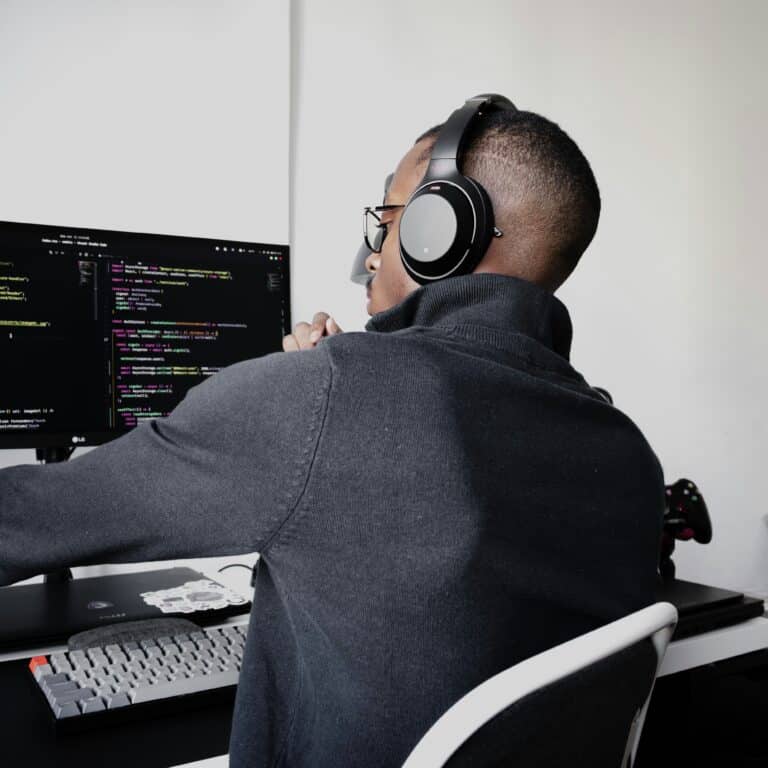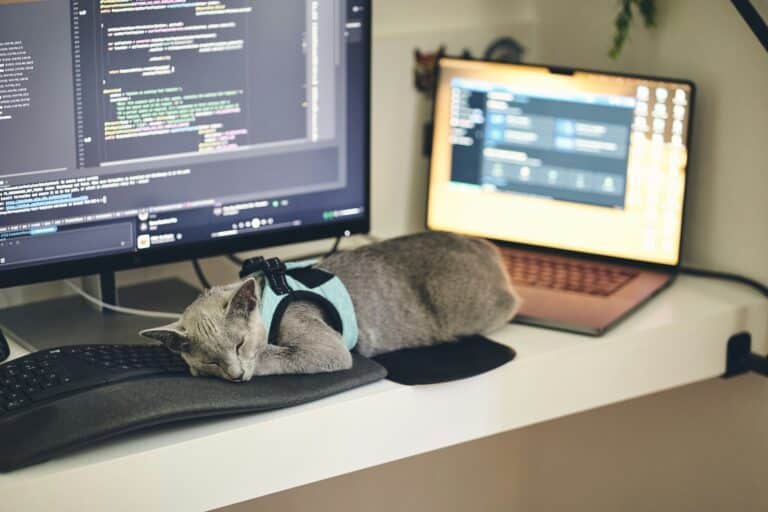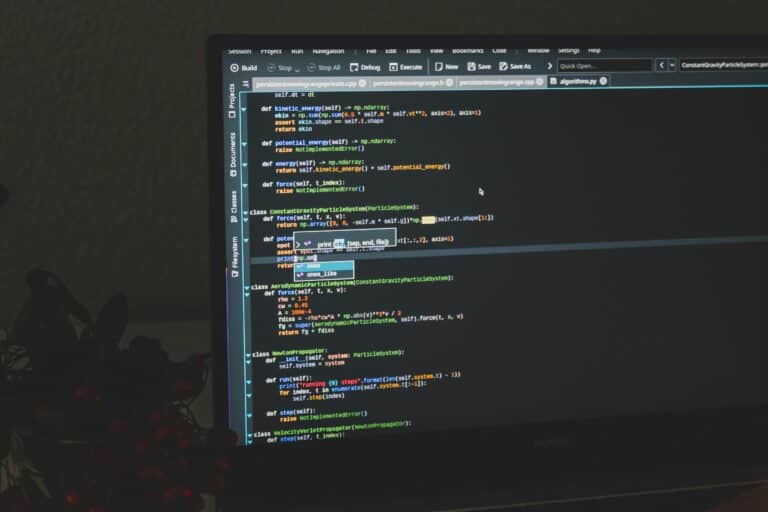In the dynamic realm of coding, a state of high-concentration known as ‘flow’ is often the holy grail. It’s that sublime state where the code seems to flow from your fingertips effortlessly, and logical solutions appear with clarity. However, achieving this level of focus can often be obstructed by a myriad of distractions – be it noisy environments, incessant notifications, or even our own wandering thoughts. So, how does one unlock their coding potential and maintain a distraction-free programming environment? 🤔

The answer lies in understanding the intersection of psychology, environment management, and software tools. In this comprehensive guide, we will delve into these areas, aiming to equip you with practical strategies to enhance your programming skills by mitigating distractions.
Unraveling the Layers of Distraction
Firstly, we’ll take a look at what science says about distractions and their impact on our ability to focus. Understanding the ‘why’ behind the distractions can provide powerful insights into managing them effectively. We will explore how distractions can derail your train of thought, causing what’s known as ‘context switching’ in the programming world, which can severely affect productivity and code quality.⏱️
Creating Your Optimal Environment
Next, we’ll venture into the realm of environment management. How can you design an optimal programming environment that supports concentration and minimizes disturbances? Whether it’s a question of the right soundscapes to foster focus, or the appropriate desk setup to promote comfort and efficiency, we’ll discuss it all.🏠
Technology as an Ally: Software Tools to Aid Focus
Contrary to popular belief, not all technology is a source of distraction. In fact, there are myriad software tools designed to help programmers maintain focus and boost productivity. From integrated development environments (IDEs) that streamline your workflow, to apps that limit time spent on distracting websites, we’ll explore the digital arsenal available to the modern coder.💻
Mindfulness and the Art of Single-Tasking
Finally, we’ll discuss the value of mindfulness and single-tasking in the world of coding. In an age of ubiquitous multi-tasking, the art of doing one thing at a time can seem like a forgotten skill. Yet, it’s often in these moments of intense single-tasking that the best code is written. We’ll discuss techniques for nurturing this habit, and how it can serve as a bulwark against the intrusion of distractions.🧘
This guide seeks to offer a holistic approach to distraction-free programming, integrating insights from various fields into a comprehensive toolkit for the aspiring coder. Whether you’re just starting your journey in programming or looking to fine-tune your skills, this guide aims to be a valuable resource. By the end of this read, you’ll be armed with a plethora of actionable strategies to unlock your coding potential, paving the way for higher productivity and quality in your programming endeavours. So, let’s dive in and start decoding distraction-free programming!
Unlocking Your Coding Potential: Setting the Stage
Imagine trying to perform a symphony in the middle of a bustling city intersection or creating a masterpiece in a room full of chaos. That’s what coding with distractions feels like. It’s an art that requires concentration and a clear mind to execute flawlessly. As a beginner, the challenge doubles. You’re trying to familiarize yourself with syntax, language rules, and problem-solving strategies all at once.
Distractions during this learning phase can be a significant barrier, causing frustration, slow progress, and even burnout. However, this doesn’t have to be your programming story. By adopting specific strategies and creating a conducive coding environment, you can pave your way to distraction-free programming, unlocking your full coding potential.
Let’s explore how to achieve this.
Creating a Distraction-Free Coding Environment
Setting up a coding environment free from distractions is not about having the most sophisticated workstation setup; it’s about simplicity and comfort. Your workspace should inspire productivity, creativity, and deep concentration. But how can you achieve this? Here are some pointers.
Firstly, ensure your workspace is clean and organized. A cluttered desk can lead to a cluttered mind. Remove unnecessary items, and keep only what you need for coding. This could be your computer, a notebook for jotting down ideas, and perhaps a cup of coffee for those long coding sessions.
Secondly, make your workspace comfortable. Invest in a comfortable chair and a desk of the right height. Remember, you’ll be spending long hours coding, and your comfort can make the difference between a productive session and an agonizing one.
Video Recommendation: “Ultimate Desk Setup Tour! – A Programmer’s Dream Setup” by Keep Productive
Get a glimpse of how a well-organized and distraction-free workspace looks like from this YouTube video by Keep Productive. It’s an excellent inspiration source for setting up your coding environment.
Mastering the Art of Focus
Coding is a cognitively demanding task. It requires deep focus and concentration. Therefore, mastering the art of focus is a crucial step in your journey to distraction-free programming.
One way to improve focus is through the Pomodoro Technique. This time management method involves breaking your work into intervals (usually 25 minutes), separated by short breaks. This technique can help you maintain high productivity levels while preventing burnout.
Another strategy is to practice mindfulness and meditation. Studies have shown that regular meditation can significantly improve attention span and focus. Moreover, mindfulness can help you stay present during coding sessions, reducing the likelihood of being distracted.
Video Recommendation: “How to Stay Focused – The Key to Being Extremely Productive” by Thomas Frank
This YouTube video by Thomas Frank provides practical tips and strategies to stay focused and boost productivity. It’s a must-watch for anyone striving for distraction-free programming.
Choosing the Right Tools for Distraction-Free Programming
Choosing the right coding tools can significantly impact your productivity levels and susceptibility to distractions.
Firstly, choose a code editor that suits your needs and preferences. Some popular options include Sublime Text, Visual Studio Code, and Atom. These editors offer features like syntax highlighting, code completion, and debugging tools that can simplify your coding process and keep you focused.
Secondly, consider using a version control system like Git. This tool allows you to track your code changes, collaborate with other developers, and revert back to previous versions of your code. With Git, you can focus more on coding and less on managing your code.
Table Comparison: Code Editors
| Code Editor | Syntax Highlighting | Code Completion | Debugging Tools |
|---|---|---|---|
| Sublime Text | Yes | Yes | No |
| Visual Studio Code | Yes | Yes | Yes |
| Atom | Yes | Yes | Yes |
Explore these tools and choose the one that suits you best. Remember, the best tool is the one that helps you stay focused and code efficiently.
Embracing Continuous Learning and Practice
Distraction-free programming is not a destination; it’s a journey of continuous learning and practice. Even the most experienced programmers face distractions. The difference is in how they manage them.
As a beginner, don’t be too hard on yourself when you get distracted. Instead, learn from the experience, adjust your strategies, and keep practicing. Over time, you’ll get better at managing distractions, and your programming skills will significantly improve.
Finally, remember to take care of your physical and mental health. Regular exercise, a healthy diet, and sufficient sleep can enhance your concentration levels and overall productivity. Plus, when you feel good, you code better.
Video Recommendation: “The BEST Programming Practices That Every Developer Must Follow” by Traversy Media
Programming involves more than just writing code. It’s about adopting the best practices and habits that support productivity and focus. This video by Traversy Media provides excellent tips on how to become a better programmer. Check it out!
Conclusion
In conclusion, we have explored in depth the intricate world of IT and engineering, shedding light on the complex concepts and mechanisms that make our modern world function. We delved into topics such as the principles of software engineering, the role of IT in our society, and how these two domains interact to create the technological infrastructure we often take for granted.
Firstly, we dived into the fundamentals of software engineering. We learned that software engineering is not simply about coding, but it encompasses a wide array of practices and principles that ensure the efficiency, reliability, and security of software applications. We also highlighted the importance of software testing and debugging, underscoring the fact that a good software engineer does not only write code but also tests and refines it to meet the desired specifications and standards.
Secondly, we examined the role of IT in our society, outlining how it is instrumental in various sectors, from business and finance to education and healthcare. We highlighted the importance of data management, network administration, and cybersecurity, painting a picture of how these different elements of IT come together to create a secure and efficient technological environment.
Furthermore, we explored the intersection of IT and engineering, underlining the synergies between these two fields. We emphasized that, in our increasingly digital world, the boundaries between IT and engineering are becoming more blurred, giving rise to new roles and opportunities for those with a background in both fields.
This article was designed to be a comprehensive guide for those who wish to deepen their understanding of IT and engineering. However, it’s worth noting that this field is rapidly evolving, with new concepts and technologies emerging on a regular basis. Thus, continuous learning and upskilling are paramount for those who wish to stay relevant and competitive in this dynamic landscape.
I hope you found this article informative and useful. If you have any comments or questions, feel free to leave them in the comment section below. Your insights and perspectives enrich our discussions and help us all learn more. Furthermore, if you found this article valuable, don’t hesitate to share it with others who might benefit from it. Knowledge is power, and sharing it is empowering.
I encourage you to delve further into these topics, using resources such as the W3Schools, a free educational website for learning web technologies online, and the IEEE Computer Society, a leading professional organization dedicated to advancing technology for the benefit of humanity.
Finally, remember that every piece of technology we use today was once a mere idea in someone’s mind. So, keep learning, keep exploring, and who knows? You might be the next person to revolutionize the world of technology! 😊👩💻🌐🚀
Until next time, keep pushing the boundaries of what is possible in the realm of IT and engineering!
<!– wp:paragraph –>
<p>Reference: IEEE Computer Society, W3Schools</p>
<!– /wp:paragraph –>



